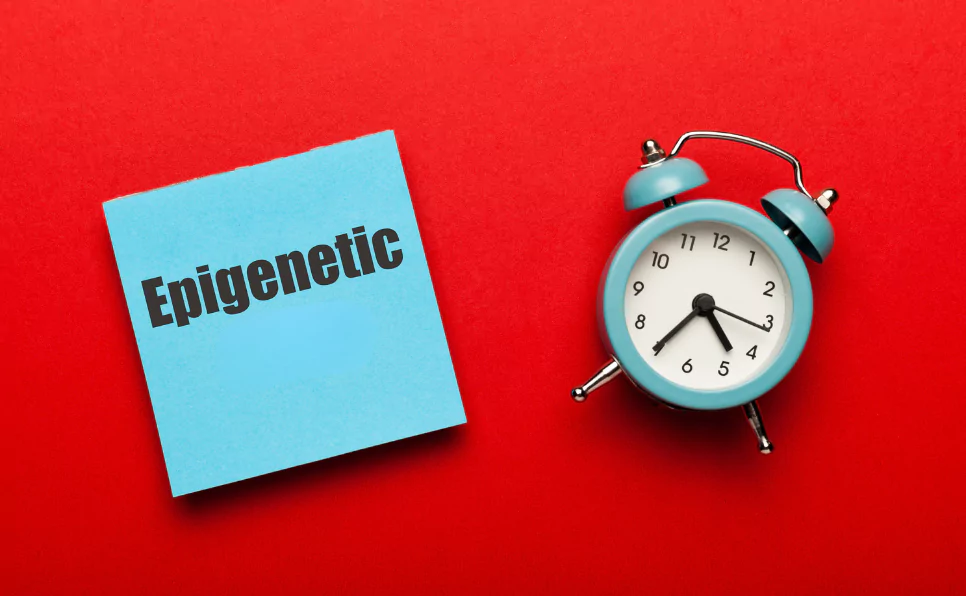Inside every cell of your body, there’s a tiny power station called a mitochondrion that keeps you energized.
But how well it works can change over time and under different circumstances! That’s where epigenetics comes in, kind of like a switchboard, adjusting our genes’ activity without changing the genes themselves based on what’s happening around us.
In this article, we will look into how mitochondria and epigenetics team up to affect our health, from giving us energy to fighting diseases.
Understanding Mitochondria
Mitochondria are fascinating organelles, primarily known for their role in producing ATP, the energy currency of the cell.
This process, known as oxidative phosphorylation, is vital for powering various cellular activities. However, mitochondria’s roles extend beyond energy production:
- Energy production through ATP: ATP synthesis is the critical function of mitochondria, providing energy for cellular processes.
- Calcium storage: Mitochondria regulate calcium levels, essential for various cellular functions, including muscle contraction and neurotransmitter release.
- Apoptosis: They play a key role in programmed cell death, a process crucial for maintaining healthy tissue and development.
- Steroid synthesis: Mitochondria are involved in synthesizing steroids, impacting stress response, immune function, and more.
These roles show the mitochondria’s importance in overall cellular health and function.
Mitochondrial DNA (mtDNA)
Mitochondrial DNA (mtDNA) is unique for several reasons:
- Structure and unique inheritance patterns: Unlike the nuclear DNA we inherit from both parents, mtDNA is passed down almost exclusively from the mother. This maternal inheritance pattern makes mtDNA fascinating for studying lineage and disease inheritance.
- Differences between mtDNA and nuclear DNA: mtDNA is circular and contains a fraction of the genes found in nuclear DNA. However, mutations in mtDNA can lead to various mitochondrial diseases, highlighting the importance of understanding its structure and function.
The Concept of Epigenetics
Epigenetics is the study of changes in gene expression that do not involve alterations to the underlying DNA sequence.
It’s a crucial mechanism by which the environment can impact gene activity. The main components of epigenetics include:
- DNA methylation: The addition of a methyl group to DNA, typically silencing genes.
- Histone modification: Changes to the proteins that DNA wraps around, affecting gene visibility and expression.
- Non-coding RNA: RNA molecules that do not code for proteins but can regulate gene expression.
This distinction from genetics is key: while our DNA sequence remains constant, epigenetic modifications can change, influencing our health and disease risk.
Mechanisms of Epigenetic Regulation
Epigenetic regulation is essential for controlling which genes are “turned on” or “off” in different cells and at various times:
- Controlling gene expression: Epigenetic marks can activate or silence genes, determining cell function and identity.
- Impact of environment and lifestyle on epigenetic marks: Factors like diet, stress, and exposure to toxins can lead to changes in epigenetic marks, affecting gene expression and potentially leading to disease.
This understanding of epigenetics offers a powerful insight: our environment and lifestyle choices can directly influence our genetic expression and health outcomes.
Mitochondria and Epigenetics
Mitochondrial Influence on Epigenetic Regulation
Mitochondria are more than just energy suppliers; they’re also signal transmitters, influencing how genes express themselves without changing the DNA sequence.
This is where epigenetics comes into play. Epigenetic modifications include DNA methylation and histone modification, essentially turning genes on or off based on environmental cues.
Mitochondria influence these modifications through their metabolic by-products, such as acetyl-CoA and NAD+, which are crucial for histone modification and DNA methylation processes.
This connection points to a fascinating aspect: how energy production and gene expression are intertwined.
Consider this: mitochondrial dysfunction, often resulting from genetic mutations or environmental stressors, can lead to a cascade of epigenetic changes.
For instance, reduced mitochondrial function can alter the epigenetic landscape, affecting gene expression patterns involved in energy metabolism, cell death, and even the immune response.
This alteration can contribute to the development and progression of various diseases, from metabolic disorders like diabetes to neurodegenerative diseases such as Alzheimer’s.
Epigenetics and Mitochondrial Diseases
Mitochondrial disorders arise when mitochondria fail to produce enough energy for the cell, leading to a range of symptoms and diseases.
What’s groundbreaking is the realization that epigenetic changes can both contribute to and result from mitochondrial dysfunction.
This bidirectional relationship opens up new avenues for treatment.
By understanding and manipulating the epigenetic landscape, we have the potential to reverse mitochondrial diseases, offering hope where there was previously little.
Implications for Genetic Disorders
Mitochondrial Dysfunction in Genetic Disorders
Mitochondrial dysfunction is at the heart of many genetic disorders.
Conditions such as Leber’s hereditary optic neuropathy (LHON) or mitochondrial myopathy are directly linked to mutations in mitochondrial DNA. However, the story doesn’t end with mutations.
The role of epigenetics in the progression and manifestation of these diseases is gaining attention.
For example, in some cases, epigenetic modifications can exacerbate or mitigate the effects of mitochondrial DNA mutations, influencing the severity of the disease.
This understanding shifts the perspective on genetic disorders, highlighting the potential for interventions that target epigenetic mechanisms.
Advancements in Treatment and Diagnosis
The potential to use epigenetic biomarkers for diagnosis represents a significant advancement. Identifying specific epigenetic patterns associated with mitochondrial dysfunction can aid in early detection and personalized treatment plans.
Moreover, emerging therapies targeting epigenetic modifications are on the horizon.
These therapies, which aim to correct aberrant gene expression patterns, have the potential to revolutionize the treatment of mitochondrial and genetic disorders.
Therapies targeting epigenetic modifications, such as drugs that can modify DNA methylation or histone acetylation patterns, are currently being explored.
These treatments hold the promise of not just managing symptoms but addressing the root cause of mitochondrial diseases by restoring healthy gene expression patterns.
Practical Considerations
Lifestyle, Environment, and Mitochondrial Health
An area of particular interest is the impact of lifestyle and environmental factors on mitochondrial function and epigenetics.
It’s becoming clear that diet, exercise, and exposure to environmental toxins can influence mitochondrial health and, by extension, epigenetic states.
This insight offers a powerful reminder of the role of lifestyle choices in our overall health.
For instance, regular physical activity has been shown to enhance mitochondrial function, potentially influencing epigenetic markers related to aging and disease prevention.
Final Thoughts
Understanding the interplay between mitochondria and epigenetics offers a window into the future of medicine.
The potential for innovative treatments and diagnostic tools stemming from this knowledge is immense.
As we continue to unravel the complexities of mitochondrial and epigenetic mechanisms, we edge closer to a future where genetic disorders can be not just managed but reversed.
This journey, while complex, is filled with hope and the promise of a healthier tomorrow for those affected by mitochondrial diseases.
FAQs
Can lifestyle changes affect mitochondrial health and epigenetics?
Absolutely. The way we live, what we eat, how much we move, and our environment can directly impact our mitochondria and the epigenetic signals in our cells. Making positive changes in these areas can enhance mitochondrial function and lead to healthier gene expression patterns.
Are mitochondrial diseases hereditary?
Yes, many mitochondrial diseases are passed down through families, especially from mother to child. This inheritance pattern is due to the unique way mitochondrial DNA (mtDNA) is transmitted, which is primarily from the mother.
How are epigenetic therapies being developed for mitochondrial disorders?
Scientists are at the forefront of designing therapies that target epigenetic modifications. These therapies aim to correct the underlying gene expression issues caused by mitochondrial dysfunction, offering a new approach to treating mitochondrial disorders.
Can mitochondrial and epigenetic changes be reversed?
Encouragingly, yes. Research shows that certain epigenetic changes are not permanent and can be reversed. This opens up exciting possibilities for therapies that could adjust these changes, potentially fixing the root cause of mitochondrial-related issues.
How do environmental factors influence mitochondrial epigenetics?
Our surroundings play a big role. Environmental factors like pollution, chemicals, and even stress can cause oxidative stress in our cells, affecting both mitochondrial function and the epigenetic mechanisms that regulate gene expression. Understanding this interaction is key to mitigating its impact.
For Further Reading:
- DNA Methylation, Mitochondria, and Programmed Aging – Biochemistry (Mosc)
- The mitochondrial side of epigenetics – Physiol Genomics
- Mitoepigenetics: The different shades of grey – Mitochondrion
- Epigenetic codes of mitochondrial homeostasis – Nature Aging
- Mitochondrial Epigenetics and Environmental Exposure – Current Environmental Health Reports
- Two genomes, one cell: Mitochondrial-nuclear coordination via epigenetic pathways – Molecular Metabolism

Dr. Sumeet is a seasoned geneticist turned wellness educator and successful financial blogger. GenesWellness.com, leverages his rich academic background and passion for sharing knowledge online to demystify the role of genetics in wellness. His work is globally published and he is quoted on top health platforms like Medical News Today, Healthline, MDLinx, Verywell Mind, NCOA, and more. Using his unique mix of genetics expertise and digital fluency, Dr. Sumeet inspires readers toward healthier, more informed lifestyles.





